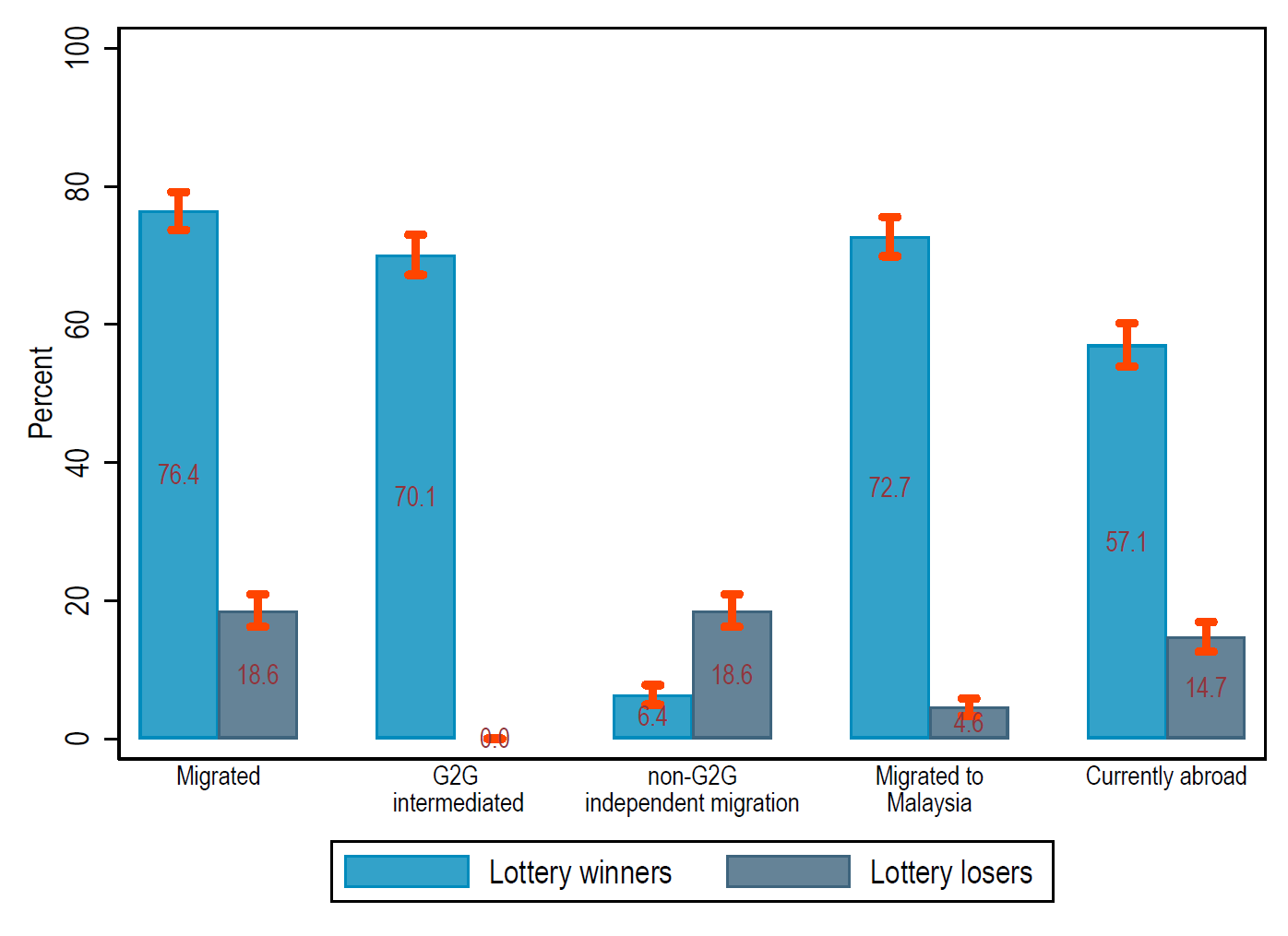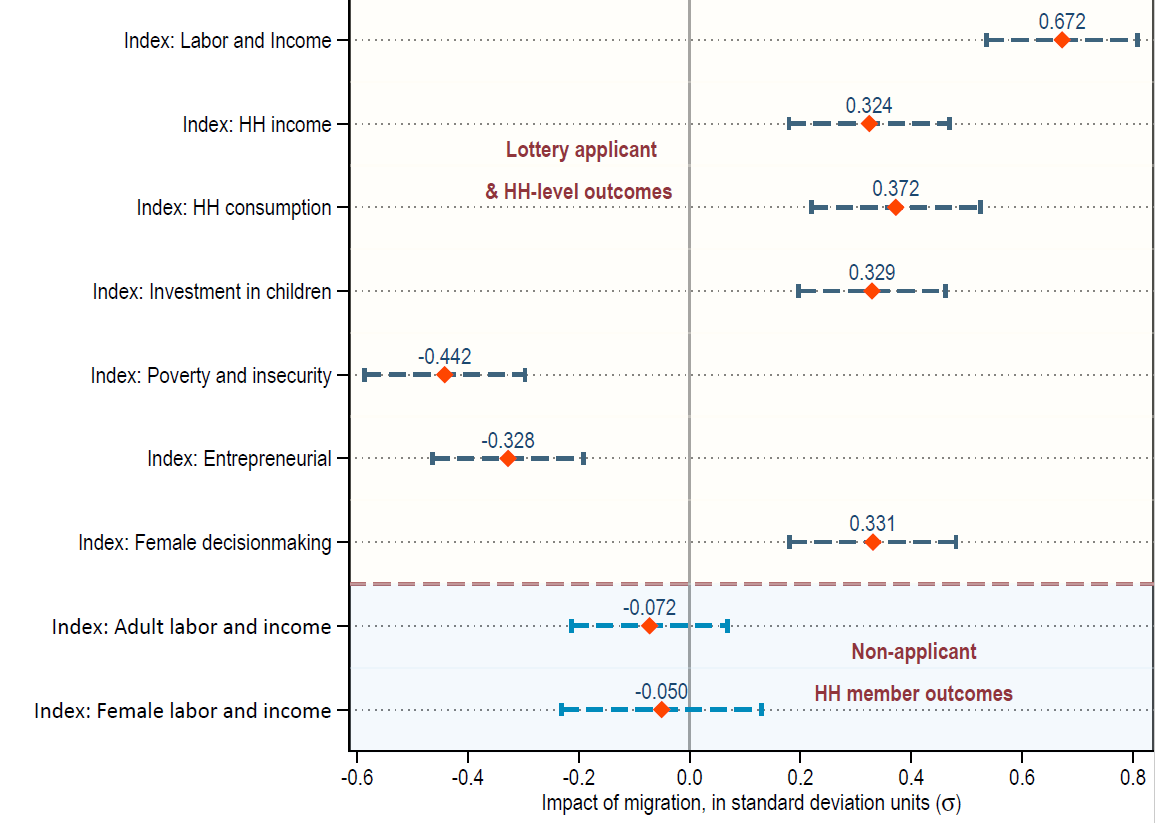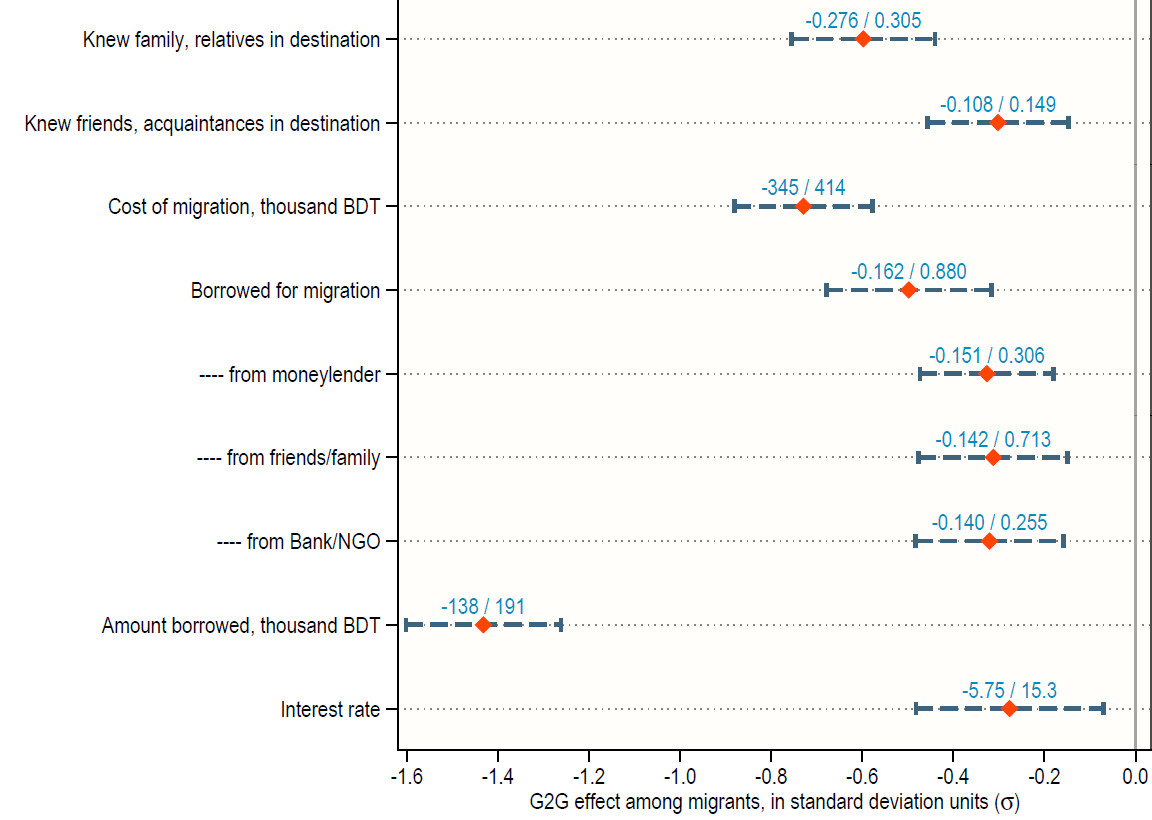
International migration can be transformative for low-skilled workers and their families, and governments can play important roles to ease the visa intermediation process, lower upfront costs, and ensure safer migration
International migration can be a powerful development intervention. Clemens et al. (2019) compute the hypothetical income gains if observationally identical prime-age low-skilled men from 42 different countries were to move to the United States. They find real wage gains ranging from 70% (Morocco) to 1640% (Yemen). Are such large gains actually realised when migrants move? In Mobarak, Sharif, and Shrestha (2023), we use a lottery that the Government of Bangladesh conducted to allocate visas to Malaysia, to study the effects on families remaining behind when migrant workers actually moved.
Of the 280 million migrants in the world, 32 million are South Asians living in richer Asian countries (UNDESA 2020). It is therefore valuable to study the effects on migrants and their families in this popular migration corridor. The research also speaks to the question of how governments can effectively mediate and support migration flows.
Context
Bangladesh sends about 500,000 low-skilled workers each year under temporary work visas to countries like Saudi Arabia, UAE, Oman, Malaysia, Qatar, and Singapore. About 10% of the Bangladeshi male labour force works abroad. Remittances sent by these workers amount to approximately 5-10% of the country’s GDP (World Bank 2022). These workers find jobs abroad through an extensive chain of middlemen (dalals) who charge fees to help them through the recruitment and visa processes.
The Bangladesh to Malaysia migration flow was halted in 2009 due to complaints about fraudulent middlemen taking advantage of migrants and employers, but in 2013, the governments of Bangladesh and Malaysia entered into a government-to-government (G2G) agreement to directly mediate, bypassing middlemen and resuming the flow of labour. Malaysia initially offered 30,000 work visas to Bangladeshis and the Government of Bangladesh advertised the opportunity in local newspapers seeking applications from interested candidates. Within a few weeks, 1.43 million Bangladeshis applied for the 30,000 visas available. The massive popularity necessitated a lottery to allocate the available visas. The typical job contract was for semi-skilled work at palm oil plantations. Male migrants would travel alone on temporary two-year contracts with the possibility of renewal.
We tracked down the families of a random sample of 3,512 lottery participants (both winners and losers) from across Bangladesh in 2018, five years after the lottery. That sample is representative of all lottery applicants residing in the three largest (of eight) divisions of Bangladesh, which house 57% of the country’s population.
Migration opportunities are scarce: winning the visa lottery substantially increases migration
As Figure 1 shows, 76% of the visa lottery winners in our sample had migrated internationally by the time of our survey. Almost all of the lottery winners migrated to Malaysia through the G2G-programme (although a few migrated on their own). Even though the lottery losers were also interested in migrating abroad, only 19% were able to migrate internationally, mostly to countries on the Arabian peninsula. About three-quarters of the migrants (in both groups) were still abroad at the time of the survey.
Figure 1: Impact of winning the lottery on migration

Notes: The Figure shows the impact of winning the lottery on migration. The bar shows the migration rates and the vertical lines denote 95% confidence interval. ‘Migrated’ is the sum of ‘G2G intermediated’ and ‘non-G2G independent migration’.
The differences in migration rates between the lottery winners and losers highlight that, even in contexts where half a million workers migrate every year, migration opportunities fall short of the latent demand. Not all who are interested are able to migrate, potentially due to lack of connections or opportunities, or the high costs of migration. For our research, this implies that we can use the lottery outcome as an instrument for migration and explore the effects of migration on lottery winners.
Migration is hugely beneficial for the migrants and their families
We find that migration is transformative to migrants and their families along multiple dimensions.
Migration increases individual incomes three-fold due to the higher wages that migrants earn in Malaysia relative to those who lose the lottery. Meanwhile, the incomes of their households in Bangladesh double because these migrants send significant shares of their incomes home in the form of remittances.
The higher income boosts the family’s living standards through higher consumption (more daily expenditures, durable assets, and land, plus better dwelling and improved sanitation facilities) and investments in their children (more nutritious food, more schooling, and lower child labour). Consequently, migration lowers poverty and food insecurity in the household. Migrant families have a lower debt burden even though migration intermediation is generally costly and often require households to take on debt. One reason is that the G2G programme lowers the cost of intermediation substantially relative to the private sector intermediation fees that other migrants are forced to pay. G2G migrants were less likely to borrow to finance migration, and even when they did, they borrowed lower amounts and at a lower interest rate.
Additional impacts of migration
We uncover additional interesting programme evaluation results and nuances beyond these direct economic benefits.
We find that migration lowers household entrepreneurship, a result which stands in contrast to the common perception (and observed correlation) that remittance incomes fuel entrepreneurship at home. The randomised lottery setting of our study allows us to unpack this by showing that individuals within households who participate in the visa lottery tend to be more entrepreneurial. Indeed, households of the (unsuccessful) lottery applicants were more than twice as likely to operate a household enterprise than the average rural households in survey areas. Therefore, rather than fuelling entrepreneurship at home, migration funnels entrepreneurial individuals away from the local economy. However, longer term follow up is required to assess whether migrants’ savings might help fuel entrepreneurship when they return to Bangladesh. It is worth noting that the observed fall in entrepreneurship is not driven by other household members working less: despite large increases in household income, other household members do not reduce their labour supply.
Migration also changes family dynamics and demographics. Migration (of males) significantly improves women’s decision-making power. When husbands are away, their spouses (have to) step into key decision-making roles beyond the traditional gender roles. This is especially true when the father-in-law does not reside in the same household.
Removal of the prime age men through migration has ramifications for demographic structure as marriage, childbirth, and new household formation slows down when men migrate. This mechanical pause can have long-lasting implications. Additionally, unmarried migrant men tend to marry more educated women when they return.
A summary of the impacts across several domains - each index summarising various related outcomes in that domain - are presented in Figure 2.
Figure 2: Summary of the impacts of migration on indexes of outcomes

Notes: The Figure shows the impact of migration on indexes of outcomes across various domains. Each index of the figure is the inverse covariance weighted index of the detailed outcomes presented in Tables 1 - 7 of Mobarak, Sharif, and Shrestha (2023). The unit of impact is in standard deviation units (σ). The red diamonds show the impact and the blue dashed bars represent 95% confidence intervals.
Governments can play an important role in lowering the cost of migration
How can government policy unlock this transformative potential of international migration? In this case, the Government of Bangladesh (GoB) recruited across all rural areas of the country (with the probability of selection proportional to the population of each sub-district), expanding migration opportunities more equitably to new areas. Consequently, the programme was able to change the type of people who migrated (Figure 3). For example, those with more limited pre-existing social network connections abroad were able to migrate through this programme.
Second, government intermediation lowered the costs of migration to one-sixth of the price charged by private sector middlemen. The baseline characteristics of G2G migrants relative to those who migrate using middlemen in the control group reveal that the lower intermediation costs of this programme opens up the international migration opportunities to a new, relatively poorer segment of the population who were otherwise not taking advantage of international migration as a livelihood option. Our results therefore imply that there are latent potential benefits of migration in labour-surplus countries currently not getting realised due to the high transaction costs. But we also observe that the $450 intermediation cost in the G2G programme prohibits even poorer people from participating in the lottery. A migration credit programme for poorer households could have the potential to expand the economic benefits of international labour migration further.
Figure 3: Differences between the G2G and non-G2G migrants

Notes: The Figure shows the difference between G2G and non-G2G migrants in terms of their networks abroad and means of financing migration. Outcomes are standardized to the relative to the control group mean and standard deviation. The effect on the non-standardized outcomes and the control group mean appear as labels separated by ‘/’. The error bars represent 95% confidence intervals.
In addition, the government elevated the quality of migration experience in a corridor where significant downsides of migration – fraud, abuse and exploitation – exist. Compared to migrants among lottery losers, government intermediated migrants were working in a riskier sector and witnessed higher rates of accidents and injuries. But they also had stronger contracts and were more likely to have insurance prior to departure. Government intermediated migrants could start almost immediately after arrival whereas other migrants had to wait two weeks longer, on average, to start work.
This programme highlights the crucial role governments of low-income countries can play in facilitating international migration. They can create safer and cheaper migration pathways through bilateral agreements with key destination countries and extend a transformative opportunity to poor households. The programme can also improve equity if the government directs these opportunities to areas and among people who might not otherwise have the networks to learn about opportunities abroad, or among people who might not otherwise be able to afford the high costs of migration.
References
Clemens, M A, C E Montenegro and L Pritchett (2019), “The Place Premium: Bounding the Price Equivalent of Migration Barriers”, The Review of Economics and Statistics 101 (2): 201–13. Available at: https://doi.org/10.1162/rest_a_00776.
Mobarak, A M, I Sharif, and M Shrestha (2023), “Returns to International Migration: Evidence from a Bangladesh-Malaysia Visa Lottery”, American Economic Journal: Applied Economics Forthcoming. Available at: https://www.aeaweb.org/articles?id=10.1257/app.20220258.
UNDESA (2020) “International Migrant Stock 2020”, United Nations Department of Economic and Social Affairs, Population Division. Available at: https://www.un.org/development/desa/pd/content/international-migrant-stock.
World Bank (2022), “World Development Indicators”, World Bank.




